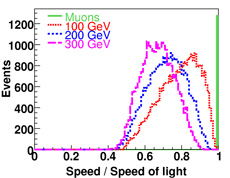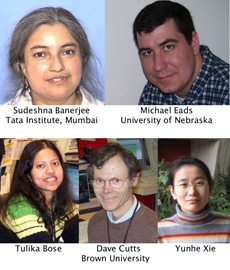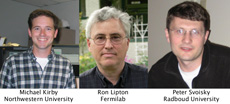DZero researchers seek special particle

This figure shows the predicted speed of the charged massive stable particles sought by the DZero researchers as a fraction of the speed of light. Normal muons travel very near the speed of light and can be clearly distinguished. The relative speeds of three potential masses for charged massive stable particles are shown in the figure.
If science were like dating, then the search for that special particle might start with a personal ad: dedicated DZero researchers seek charged massive stable particles that could shed light on the future of particle physics.
The Tevatron's numerous proton-antiproton interactions provide data where that special particle may reside. But still, finding that particle's signature amongst the many ordinary particles is a difficult task. DZero scientists hope the key to finding a perfect match is simply looking for specific traits that imply the particle fits DZero's high standards: massive, charged and stable.
For physicists performing the search, the particle's speed is a great indicator of whether the particle is a keeper. After a charged particle has been produced, it will leave a signature in DZero's tracking detectors. If it is also stable, it will not decay before it leaves the DZero detector and will appear very similar to a muon. But if the particle is massive, it should move relatively slowly compared to muons, which travel near the speed of light.
Exotic theories, such as supersymmetry, predict the existence of charged, massive and stable particles. This theory could potentially explain many of the mysteries of the universe, from dark matter to the Higgs boson. Two possible candidates for this particle predicted by supersymmetry, are scalar tau leptons (staus) and charginos.
DZero physicists searched for charged massive stable particles in 1.1 inverse femtobarns of data. They found no evidence for such a particle. However, the search results allow DZero researchers to set upper limits on the production rate of staus and on the possible masses of charginos. This greatly improves on results from searches at the LEP collider.
DZero researchers didn't find what they were looking for this time, but they plan to remain on the prowl. With three times more data recorded and significant analysis improvements on the way, these physicists aren't ready to give up searching for their special particle.

A team of DZero physicists made primary contributions to this analysis.

The DZero SMT radiation monitoring team provides tools to carefully monitor the radiation dosage delivered to DZero's silicon microstrip tracking detector by Tevatron interactions. By minimizing radiation damage to the SMT, the team helps ensure high-quality tracking data to help make possible the many analyses at DZero that rely on charged-particle tracks.
|